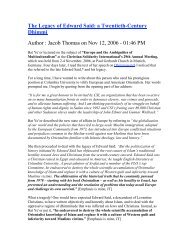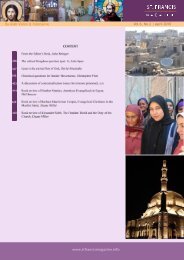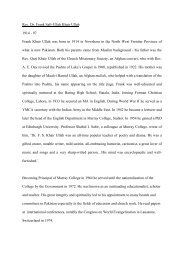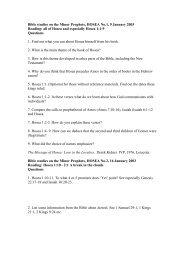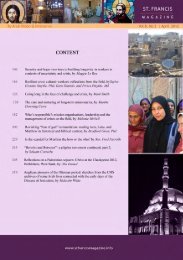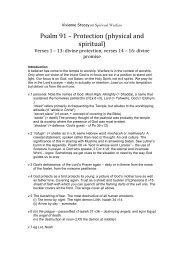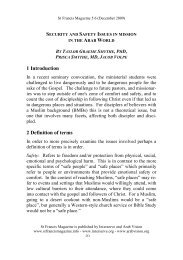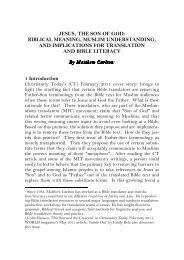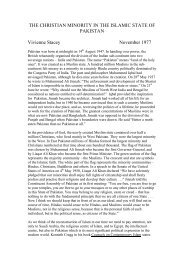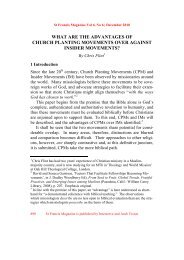download the pdf - St.Francis Magazine
download the pdf - St.Francis Magazine
download the pdf - St.Francis Magazine
You also want an ePaper? Increase the reach of your titles
YUMPU automatically turns print PDFs into web optimized ePapers that Google loves.
<strong>St</strong> <strong>Francis</strong> <strong>Magazine</strong> Vol 8, No 4 | August 2012<br />
erature concerning contextualization <strong>the</strong>ory (see, e.g. Wilder 1977,<br />
regarding self-supporting groups of insiders in two or three Turkish<br />
cities which had existed for 45 years, cited by Travis and Travis<br />
2005: 398, 405) and claims still earlier roots (cf. McGavran 2005).<br />
Yet <strong>the</strong> phenomena itself, and <strong>the</strong> terminology used for it, was not<br />
unambiguous. Preferring an indigenous church-planting model,<br />
Garrison (2004: 153) characterised Insider Movements (<strong>the</strong> capitalisation<br />
is his) as: “difficult to define, confirm or characterize” and<br />
noted that “[t]hey range from <strong>the</strong> real to <strong>the</strong> ambiguous to <strong>the</strong> illusory.<br />
Where one has been well documented, it raises questions of<br />
whe<strong>the</strong>r it is unusual or typical.”<br />
In contrast, o<strong>the</strong>r claims regarding insider movements were far<br />
less reserved. Higgins (2004: 155, 156, 163) paralleled <strong>the</strong>ir “earthshaking”<br />
potential with <strong>the</strong> C16th Reformation, and considered that,<br />
as “an emerging reformation,” insider movements would “be fuelled<br />
by <strong>the</strong> rediscovery of culture and religion.” Higgins was not alone:<br />
Kim (2006) drew similar comparisons with <strong>the</strong> Reformation. Seeing<br />
any movement to Jesus as an insider movement in <strong>the</strong> sense that it<br />
is culturally located, Higgins located <strong>the</strong>ir rationale within <strong>the</strong><br />
church of Acts, and supplemented <strong>the</strong> case for MBBs staying in<br />
mosques via appeal to 2 Kings 5 and <strong>the</strong> Samaritan mission in John<br />
4, Luke 10 and Acts 1:8. Judging <strong>the</strong> gospel to fulfil cultures, Higgins<br />
implicitly drew on <strong>the</strong> critical contextualisation advanced by<br />
Hiebert (1985: 195-196) when anticipating that such movements<br />
would become self-<strong>the</strong>ologizing such that <strong>the</strong>ir local critical contextualization<br />
would include, but not be limited to, ‘a new “Jesus” reading<br />
of <strong>the</strong> Quran.’ (Higgins 2004: 163) Later Higgins went fur<strong>the</strong>r,<br />
suggesting <strong>the</strong> possibility of a no longer extant ‘original Islam’<br />
within <strong>the</strong> Qur’an’s origins, which “may well be in closer (if not<br />
complete) harmony with biblical truth.” (Higgins 2007: 38, 40n27)<br />
Massey, ano<strong>the</strong>r advocate of C5, continued his earlier strident<br />
defence, arguing “His ways are not our orthodoxy.” (Massey 2004c)<br />
Several dichotomies followed, including that between “Greco-<br />
Roman categories of orthodoxy” and “a Jewish understanding of<br />
Christ’s mandate;” (p.296) viewing C5 from a distance as opposed to<br />
experiencing it from within personal relationships (p.296); and mis-<br />
<strong>St</strong> <strong>Francis</strong> <strong>Magazine</strong> is a publication of Interserve and Arab Vision 466




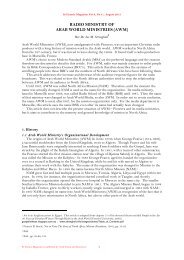
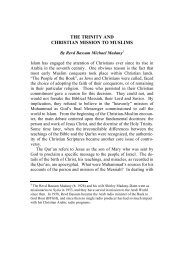
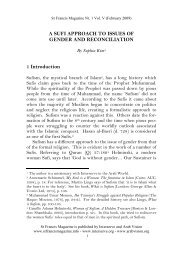
![Reflections on Surah Fatiha and the Lord's Prayer[1] - St.Francis ...](https://img.yumpu.com/49377951/1/184x260/reflections-on-surah-fatiha-and-the-lords-prayer1-stfrancis-.jpg?quality=85)
